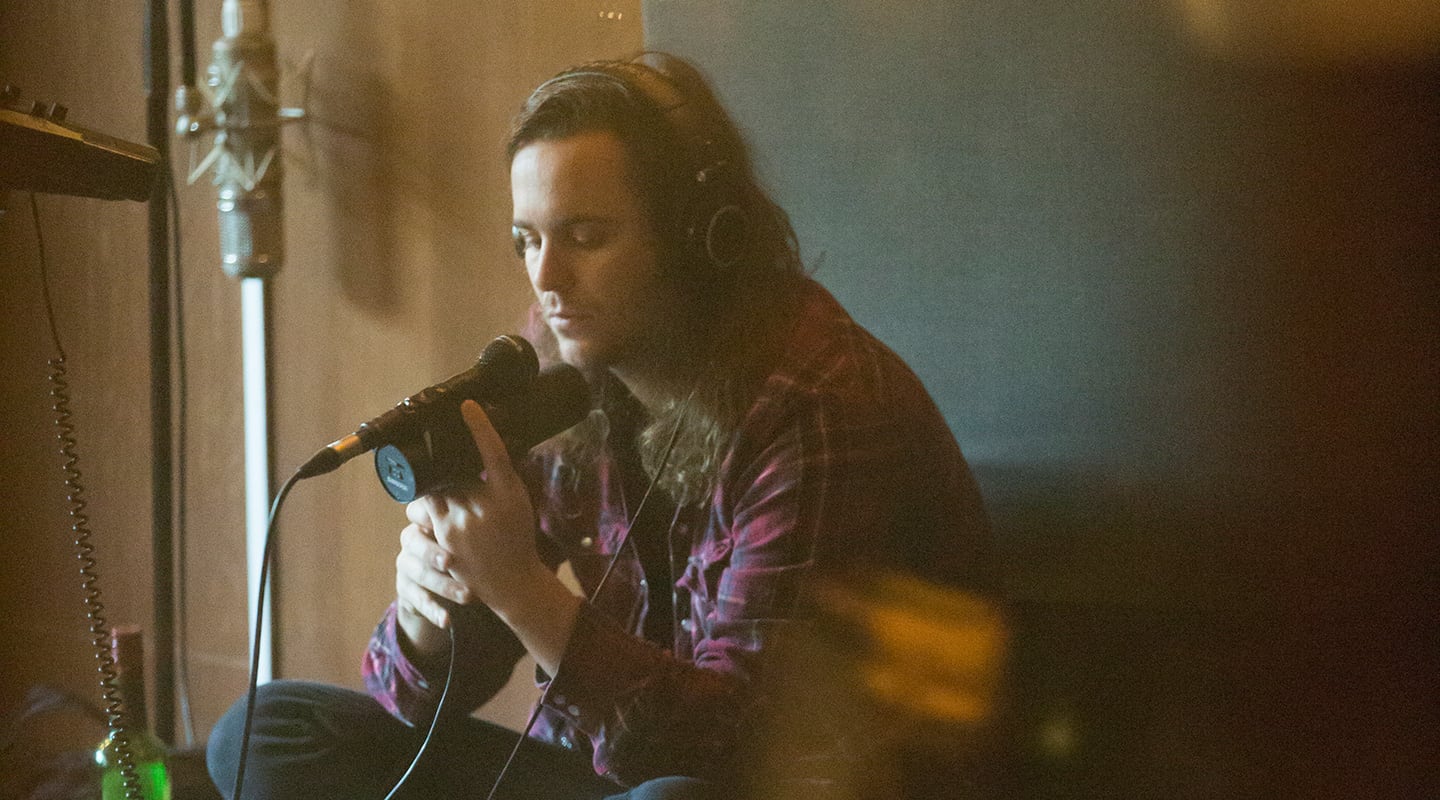
‘Til Death Do Us Part
DZ Deathrays will do anything to make their two-piece sound huge. Even if that means breaking every part down to the Nth degree.

Artist: DZ Deathrays
Album: Bloody Lovely
DZ Deathrays kept things much the same when making their latest record, Bloody Lovely. They went back to the same studio, Grove Studios, with the same producer, Burke Reid. However, if they could avoid repeating just one mistake, it would be subjecting themselves to Reid’s “Nazi march music”.
They hadn’t quite nailed down tempos for their last album, Black Rat, before entering pre-production. Having partied all night, they rocked up to the studio in a haze to Reid’s metronome contraption. A drum machine app thumping out a kick and snare in tandem through an Orange Speaker and amp. “It was super military-sounding,” recalled vocalist/guitarist, Shane Parsons. “He just faced it at us, turned everything up to 10 and fell asleep on the couch.”
The importance of a couple of bpm isn’t lost on the pair though. “It was so painful,” said drummer Simon Ridley. “But sometimes slowing down or speeding up a song by two bpm can make the vocals sit so much better.”
It wasn’t just tempi, the process of weeding out mistakes and refining their recording process became contagious. Instead of corralling all the vocal takes into a couple of days like they have done, they staggered the sessions. “Doing all the guitars then doing all the vocals is a mistake,” said Parsons. “You just wear your voice out singing for five or six days straight. This time we’d do two songs in one day, guitars then vocals, which worked a lot better.”
SHELL OF A DRUMMER
Exemplified by nailing down the tempo to the exact bpm, that attention to detail extended to every other recording process, too. When they tracked the drums, Reid asked Ridley to record the cymbals in a different take to the rest of the drums. “In a recording environment, mics placed further away from a drum kit produce fuller sounds,” explained Reid. “Especially when you start smashing them up. But when you have cymbals in there, they take up a lot of real estate and can kill the vibe fast.”
On the drummer’s part, it takes absolute dedication. “Playing the cymbals separately is a nightmare,” said Ridley. “It’s really tough. You learn the songs, then you have to relearn how to play them without half the instrument, but it sounds good.” They took the same approach on the last album, but this time, rather than hitting fresh air, Ridley brought in some electronic drum cymbal pads so he could use them to trigger actual samples during takes. He also pared down the number of kits to just one, compared to the variety on Black Rat, for which they recorded “different kick drums within a song. The verse drums could be one thing, then the chorus drums an entirely different kit.”
Even though he separates the cymbals from the shells, Reid does keep the hi-hats in the original take. He sets up the mics like he would when recording a standard drum kit setup: overheads, room mics and all [see Drum Mics sidebar]. Then when he’s done recording the main kit, he’ll put the cymbals on, leave the drum mics where they are and reposition the overheads, “so they EQ themselves a bit,” explained Reid. “I’ll angle them in a friendlier way, and maybe pull them up a little so you don’t get that gong effect. I leave the surrounding mics in the same position, so when layering it in with the drum mics, I’m pushing up the same mics so they blend.”

On the cymbal takes, Reid keeps the room and smash mics in the same position, being able to decide how much to compress those is a big part of the appeal. “You might send the cymbals to the parallel compression to help with the blend, but monitor how much of the signal actually goes to the effect. That way, when kicks and snares hit, they’re pulling at the cymbals so it feels like they’re in the same blend, but it’s just not overdone. Where I really want to smash the kit mic to get the beefiness of the sound, I would be sending the drum room mics to the compressor at 80%, and send the cymbals at 20 or 30%.”
SPLIT DECISION ON GUITAR
Reid doesn’t fetishise drummers’ pain. He doesn’t strip them of their shiny metal discs for his own satisfaction. He does it for the greater good. In the case of DZ Deathrays, it’s to turn the sound of a two-piece rock band into something far bigger.
Parsons knows this applies to his guitar sounds as well, and purposefully only uses Garageband’s built-in presets so he doesn’t get too attached to the way the demos sound. When the band performs, they have another guitarist onstage, but Parsons splits his signal with an octave pedal to give the impression of a bass player. “I split it into a bass amp, via a couple of DIs. They’re EQ’d, with some distortion,” explained Parsons. Typically they’d record that sound as a building block for their records, but this time it wasn’t working, so they changed tacks.
“It just didn’t sound great, so we ended up using a shitty $200 bass an assistant brought in from home,” said Parsons. “I did all the parts in about three or four hours, because it’s the same thing as the guitar, so I wasn’t re-writing parts. It was weird using a bass, but it was one of those things where it just sounded bad pitching the guitar down.”

“Some of it was the way octave pedals work,” said Reid. “When they try to grab the note, it doesn’t always keep it as tight. Due to the faster tempo of some songs, they were getting a little messy and not as defined. We had to go a more traditional road and use a bass guitar, which created more depth anyway. The thing with those guys, they’re just happy with whatever is going to make the song better.”
It seemed that every pain point on the record was worth it. For instance, one of Parson’s favourite pedals is a Boss Slicer, which is a modulated, MIDI-syncable tremolo that can get incredibly glitchy. Sometimes that glitchiness would be too sharp for the record, and while Reid struggled to mix it into Afterglow, once he nailed it, it became one of the most dynamic mixes on the record. “I think we just softened up with delay, which made everything stretched a bit, rather than a really hard cut,” said Parsons.
Reid said that sometimes with mixing it’s just a matter of “doing things in the opposite way to what I was. Reimagining what something should be until it fits.”

RIFFING ON VOCALS
They’ve never struggled writing hits in the past, but this time DZ really wanted to home in on some festival bangers. “I wasn’t just trying to write a riff, I was trying to write a song,” said Parsons. “We can write riffs for days, but now more of my goal is to find that awesome vocal hook I can write a riff around, which is the hardest part.”
Parsons also finds his vocals difficult to deliver. Reid helps him out by recording guide tracks [see Vocal Tuning Guide tip], but a big part of nailing a performance is getting in the zone. Reid will usually give Parsons a dynamic mic. “He works really well on either a Shure SM7 or SM57,” said Reid. “I’ll rig it up, sometimes taping mics together so I could fix on the pop shield and give him something more to hold. It looks ridiculous, but it means he can move around as much as he wants. Sometimes a Neumann U87 condenser works to smooth out where Shane’s vocal register is. I was using one as a drum room mic, and I’d get him to use it for talkback. It sounded cool so I got him to use it for vocals. We’ve tried the big boys like the U47, but they don’t really work in that context. We also tried an RE20, which sounded cool, but it couldn’t handle being banged around. Then I’d push up whatever drum room mics I had laying around and record that at the same time.”
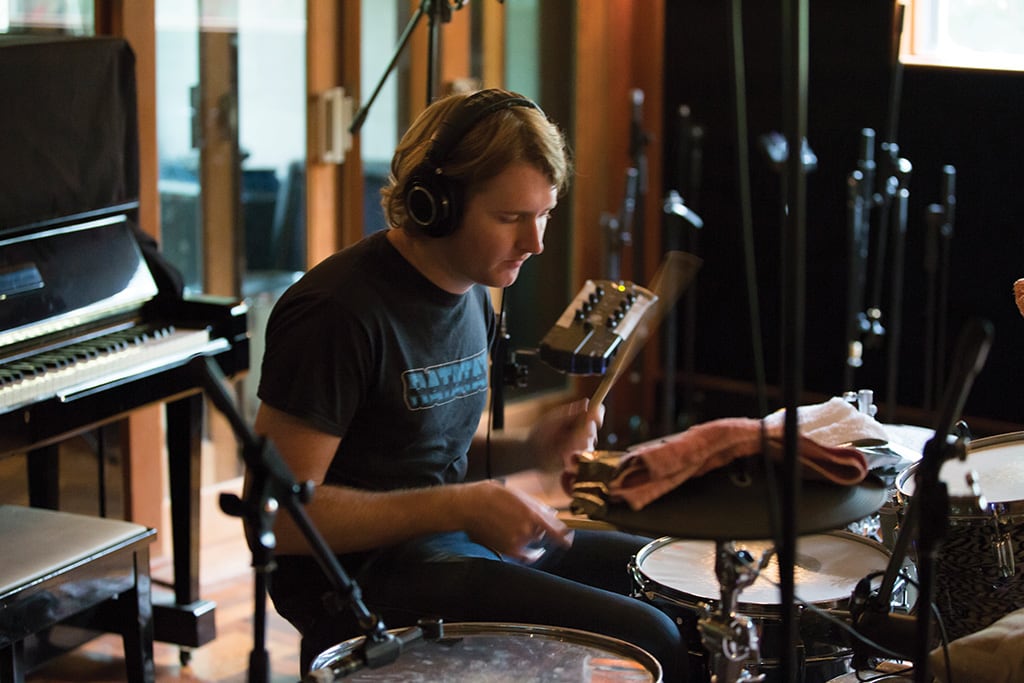
DISTORTED REALITY
Laying down cymbal-less drums, splitting up guitar lines, and re-recording melodies takes its time. By the end of the two weeks allocated to tracking, the pair would usually be on the phone begging the label for more time. Surprisingly, they managed to finish Bloody Lovely with enough spare time to have a barbecue. “Usually we’re pulling our hair out,” said Parsons.
After tracking, they left Reid for a while to get on with mixing. While Reid says he’s trying to maintain a better work/life balance, when he’s recording and mixing “I definitely disappear from society. It seems to be my process of making albums, it’s all-encompassing.”
“He always looks frail at the end of a mix, because he puts so much of himself in there,” said Ridley.
After a few songs are mixed, he’ll send them off to the band to make sure he’s on the right track. “I work on multiple songs at once because I tend to lose my mind if I work on just one.”
“It’s hard to mix a band like us,” said Parsons. “Burke wants it to sound big and ballsy. He loves a hip hop-sounding kick, not a big spikey rock kick. The problem with that is it takes up so much space. It’s a balancing act. We really like the end product. It’s not too compressed, which can wear your ears out.”
Speaking of compression, “there was some magical compressor Burke would turn on, and everything would sound amazing,” recalled Parsons. “Every time he put it on flowers would be blooming.”
The magical compressor was an old Australian made AWA mono tube compressor that Reid had been getting right into. “It’s like an Australian Fairchild,” said Reid. “The one we’ve got has been modded with an attack and release time. It’s not super fast, but it’s really musical. When it compresses, it doesn’t have a motion to it, it’s more like a limit. I send a bunch of drum mics to it and record that. It hardlines them and puts in harmonics. It’s not for every mic, but works really well on some. I also use it on vocals, bass, anything that’s going to be a mono instance. The way it reacts to transients, I’ve not yet found many other compressors that behave like that.”
Outside of the AWA, Reid prefers to use analogue hardware to distort or saturate parts, rather than heavily compressing them. “When you drive the pres on the SSL console at the Grove, they sound really cool,” he said. “I’ll take a microphone and push it until it starts distorting, which brings out overtones and notes. When you’re really distorting the drums, it turns them into 808 sounds, so you can hear if the kick or floor tom is out of tune. I’ll tune the drums listening to a really distorted mic.”
Distorting drums enough to make them sound like an 808 might sound extreme, but clean, orthodox recording methods don’t help a two-piece rock band sound larger than life. “With DZ, what helps is not necessarily what’s appropriate,” said Reid. “I always listen to what the band wants. I guess I try to strap the band on the mix bus.”
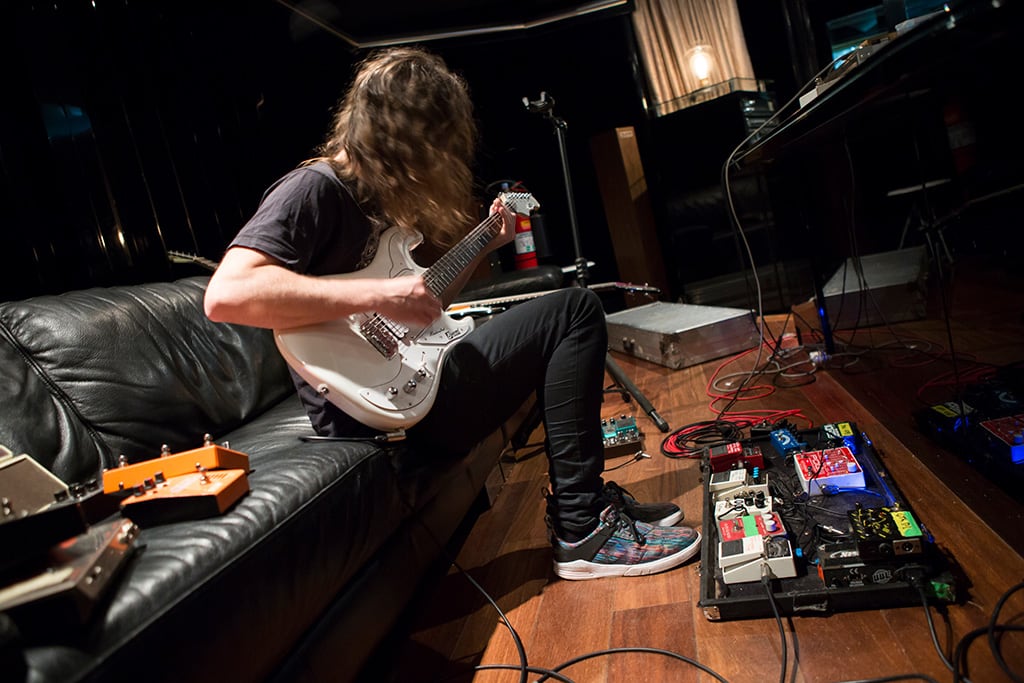

















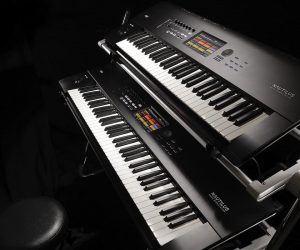





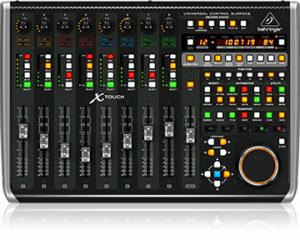



RESPONSES